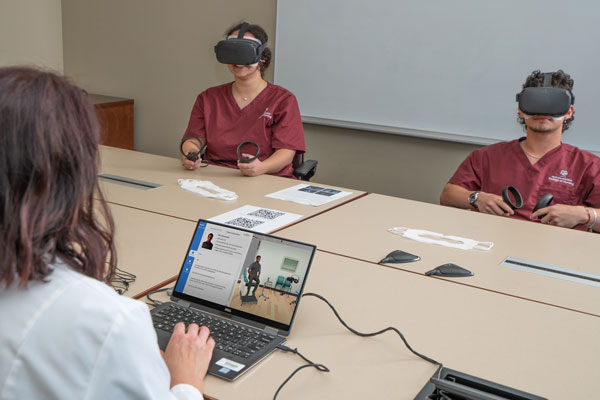Experience without consequences: Technology trains new A&M nurses

Before nursing students at Texas A&M University ever enter a clinic, even before they engage in face-to-face clinical scenarios with people acting as patients, they already have hours of experience interacting with patients. They’re accomplishing this through new, innovative virtual reality (VR) simulations developed by their professors.
Since early 2020 (in the pre-pandemic days), a team at the Texas A&M College of Nursing has been working on integrating VR simulations into their curriculum to help bridge the gap between classroom and clinic. They have launched two simulations so far that provide immersive experiences for students to hone their skills before working with real patients.
“VR simulation is in that area that we call a ‘safe container,’” said Elizabeth Wells-Beede, clinical assistant professor at the College of Nursing. “We’re all human and mistakes are going to be made. This is a place that we hope to create that psychologically safe environment for mistakes to be made, where we as the experts can help walk the students through the processes, and then they take that experience into practice and not make the mistake with a real-life patient.”
Clinical simulation is not new. It has been used in nursing education for many years and allows students to apply the theory they’ve learned from books and skills they’ve learned in labs (such as checking vital signs, inserting IVs and conducting evaluations) to patient scenarios that they could encounter in a clinical setting. In a traditional simulation, a student is presented with a standardized patient (or trained actor), a mannequin or a computer-based program, to name a few. The student must work through the case presented to them by reading the patient’s chart, interviewing the patient and conducting an examination to decide what action to take.
Virtual reality is a new, emerging form of clinical simulation that provides more accessible and immersive experiences that don’t require learners to travel to clinical settings, helping with the increasing burden on clinical practice partners to place learners.
The technology used at Texas A&M is being developed in close collaboration with Jinsil Hwaryoung Seo, associate professor and director of the Institute for Applied Creativity at the Texas A&M College of Architecture. Nursing faculty write the clinical scenarios and then work with Seo and her students to turn those scenarios into immersive, virtual reality experiences.
To access the simulated world, nursing students put on VR headsets that transport them into a virtual setting that can be a clinic, home or school. There, they meet with a virtual patient and work through their case to make a decision while their instructor observes and provides feedback.
“I am convinced VR is the future of simulation,” said Cindy Weston, associate dean for clinical and outreach affairs at the College of Nursing. “This is an immersive platform that’s deeper than what we’ve been able to do in the past with simulation in the other variety of forms it takes. Student learners feel like they’re in the environment, and it’s a safe space for them to hone and develop skills with faculty guidance and feedback.”
Currently, the College of Nursing has applied VR simulation in two areas: Screening, Brief Intervention and Referral to Treatment (SBIRT), and forensic nursing. SBIRT is an approach that health care providers use to quickly recognize when a patient uses drugs and/or alcohol in risky ways so that they can provide brief intervention and refer them to specialty care if more extensive treatment is needed. Forensic nurses are professionally trained to treat victims of violence through patient-centered, trauma-informed care. Both SBIRT and forensic nursing involve patients in vulnerable situations that require highly competent, compassionate and experienced care providers.
“We know that when confidence is high, nurses’ performance, retention, and their ability to perform the skill is high,” Weston said. “VR simulation builds their confidence and then we’re able to assess their competence before they head into the clinical setting.”

